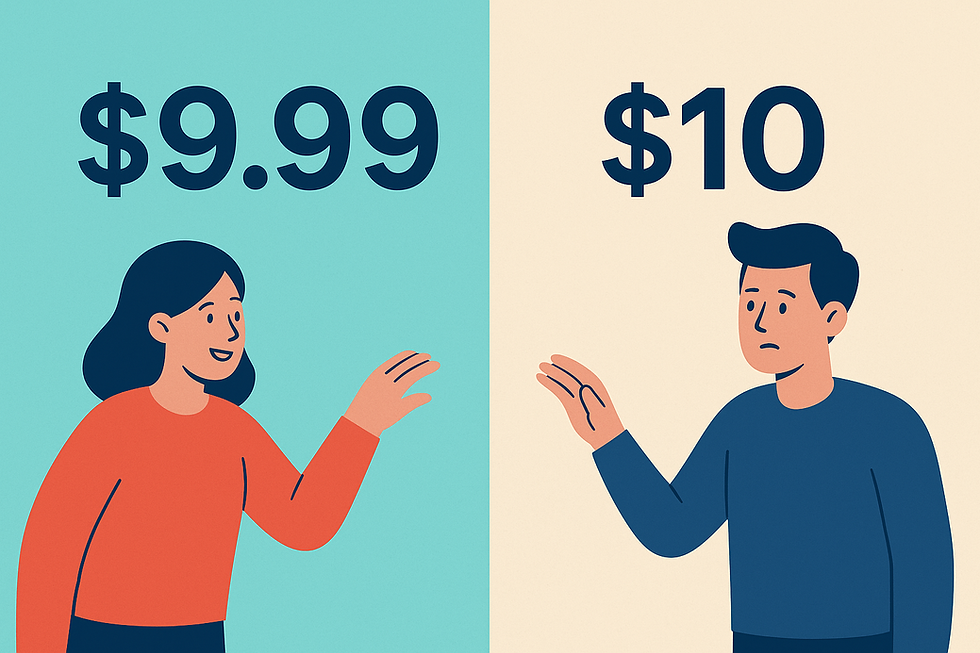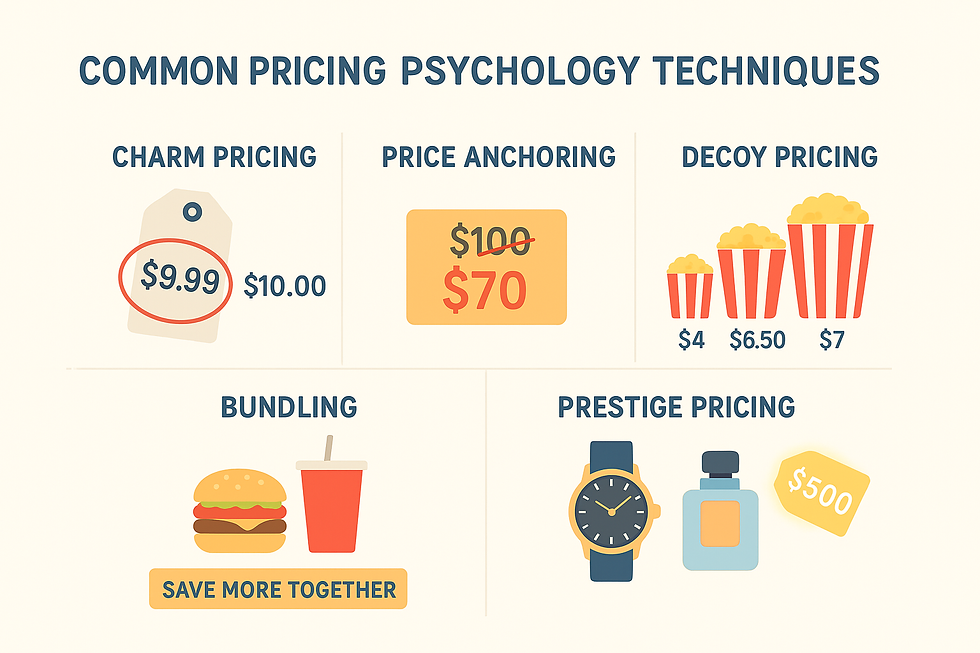The Psychology of Pricing: Set Prices that Drive Sales
- ClickInsights

- Sep 26
- 4 min read
Introduction
Have you ever wondered why $9.99 seems like such a better deal than $10? Why do people often choose the "middle option" on a pricing page even if it is not the most affordable? These decisions are rarely based only on logic. Instead, they are influenced by the psychology of pricing, a powerful aspect of sales psychology that affects how people perceive value and make purchase decisions.
Pricing is not merely about beating the competition or covering costs. It is about presentation, the feelings it evokes, and the message it sends to customers. Getting pricing strategy right can cut through hesitation, establish trust, and get more conversions. Here, we are going to examine how pricing psychology functions, the best strategies businesses can employ, and the ethical ways to implement them to fuel sales and loyalty.

What is Pricing Psychology?
Pricing psychology is the study of how individuals think about and respond to prices. It makes clear that consumers rarely assess prices independently. Rather, they contrast, compare, and judge whether a price sounds reasonable or worth it. Tiny variations, such as deleting one cent or framing a discount differently, can have a massive impact on buying habits.
For instance, people tend to purchase more of a product that costs $9.99 compared to one that costs $10, despite the difference being a penny. This is because our minds process the leftmost digit first, thus making $9.99 appear nearer to $9 than to $10. Subtle variations in perception can significantly affect sales results.
Why Pricing Matters in Sales Psychology
Pricing immediately influences the way customers think about the value of a product. An effective pricing strategy accomplishes more than making money. It influences the buying experience. When prices are set correctly, they lower resistance, build confidence, and stimulate action.
In the psychology of sales, pricing serves three important functions:
Perceived Value: The price communicates what the product is valued at and drives quality expectations.
Anchoring Effect: Price comparisons are made based on the initial number seen, creating a mental anchor.
Trust Building: Honest and uniform pricing builds long-term trust with customers.
Common Pricing Psychology Techniques
Charm Pricing
Pricing items at $9.99 rather than $10 makes things seem less expensive. This method is easy but extremely effective at boosting conversions.
Price Anchoring
Showing a greater "original" price first before revealing a discounted price makes the offer appear more appealing. A product lowered from $100 to $70, for instance, is perceived as a steal, even if $70 is not the desired selling price.
Decoy Pricing
Adding a third price point leads customers to a preferred alternative. For example, a small popcorn for $4, a medium for $6.50, and a large for $7 makes the large appear to be the value alternative.
Bundling
Selling products in combination at a lower price than if they were sold separately creates higher perceived savings and motivates larger purchases.
Prestige Pricing
At times, higher prices actually increase sales by communicating higher quality. This is used to their advantage by luxury brands, since consumers tend to associate price with exclusivity and status.

Developing a Pricing Strategy that Engages Sales
Your pricing strategy should fit your brand positioning and consumer expectations. With budget-conscious segments, charm pricing and discounting are the most effective. With premium segments, prestige pricing, and scarcity can be value.
Smart Companies tend to use a combination of techniques. For instance, software companies will often have a three-tier pricing strategy: a low-end offering, a mid-range "best value" offering, and a high-end offering. The mid-range is positioned to appear most enticing, channeling customers toward it.
Ethical Considerations in Pricing
Though the psychology of pricing may generate sales, it needs to be utilized ethically. Deceptive strategies like spurious discounts or clandestine charges will provide short-term gains but lose trust over time. Consumer’s value openness, and brands that are fair-minded tend to keep customers loyal. A McKinsey report on pricing strategy reveals that firms with open and considerate pricing policies can attain both higher profitability and tighter customer trust.
How to Test and Sharpen Your Pricing Strategy
No one approach fits all businesses. Testing is essential. Try these methods:
Test alternative price levels or discount structures.
Measure conversion rates, average order value, and profit margins.
Engage with customers and ask them how they view your pricing.
Over time, this data-driven process ensures your strategy keeps up with market trends and customer expectations.
Common Mistakes to Avoid
Over-complicating pricing systems: There are too many options to confuse shoppers.
Overlooking the psychology of customers: Pricing based on costs alone ignores the emotional element of purchasing.
Not keeping up: The market and competitors evolve, and prices should be checked often.
Keeping these mistakes at bay guarantees your pricing strategy remains effective and long-term.
Conclusion
Pricing psychology shows that prices are not just numbers. They affect perception, emotion, and decision-making. By using tested principles of sales psychology like charm pricing, anchoring, and bundling, you can lead customer behaviour and boost sales.
An optimally designed pricing strategy does more than drive profit to its highest level. It earns trust, reinforces brand positioning, and establishes a sense of value that resonates with customers. Companies that master the psychology of price drive not only increased conversions but also a sustainable competitive advantage. In this rapidly moving market environment, how people think about prices is not a matter of choice but necessary for long-term growth and customer loyalty. For a deeper dive into how psychology shapes buyer decisions, check out our guide on The Psychology of Selling: Influence Buyer Behaviour and Close More Deals
Call-to-Action
For anyone that wants any further guidance, ClickAcademy Asia is exactly what you need. Join our class in Singapore and enjoy up to 70% government funding. Our courses are also Skills Future Credit Claimable and UTAP, PSEA and SFEC approved. Find out more information and sign up here. (https://www.clickacademyasia.com/psychology-of-selling).



Spending time outdoors can be a refreshing way to connect with someone special, and planning a thoughtful picnic can turn a simple outing into a memorable experience. Tips on sofiadate.com/dating-tips/picnic-date-ideas provide creative suggestions for organizing a picnic that feels both romantic and enjoyable, from choosing the ideal location to preparing foods that are easy to share. A successful picnic blends attention to detail with a relaxed atmosphere, allowing both people to feel comfortable while enjoying the natural surroundings. By focusing on shared experiences rather than perfection, these outdoor dates create opportunities for genuine connection and playful interaction.
Planning a picnic thoughtfully involves considering not just food and setting, but also the mood and activities that encourage conversation and laughter. Incorporating small…
Enjoy some eye-witness moments with the service of premium Delhi Call Girls. Every meeting with our exclusive Call Girls Service in Delhi is held in absolute privacy and with complete luxury. Our fiery and romantically inclined Delhi Call Girls are best suited for fiery coitus and amenable company.